
Everyone knows China and Chinese products usually make up a huge percentage of the Global electronic sector.
New all big corporations have at least one production facility set up in China, So, a public loc down by the Chinese government could cause huge losses to the companies.
And, that’s exactly what’s happening to Apple.
The News:
Apple Inc. likes to declare that the supply chain of its company is international and that it's not heavily dependent on China.
But the truth is that Apple is incredibly dependent on China for its manufacturing, and this dependence has created problems for investors, the company, and customers during the outbreak.
It was particularly apparent during Apple's second-quarter phone conference last week, during which Apple cautioned that supply shortages triggered mostly by the COVID-19 lockdowns in China could impact sales by as much as $8 billion. It's equivalent to losing a full period of iPad sales.

During the conference call, Apple's Chief Executive, Tim Cook, reiterated the stance that the supply chain of Apple can be described as "truly global," with items made all over the world, including in the U.S. It's also clear that Apple could move some parts of its manufacturing to China.
Cook said that Apple might be looking to expand its offerings of this, noting that a rising number of chips are made in the US. "We continue to look at optimizing," Cook said.
As of now, Apple gets many of its components from outside China. The components that make up Apple's iPhone, iPad, Mac, and many other devices are manufactured across the globe, starting from the U.S. to India, Vietnam, and Japan.
However, the main bottleneck in the production process can be found in assembly processes, which are recognized within Apple and the manufacturing sector as FATP. It is the acronym for Final Assembly, Test, and Packing.
The majority of Apple devices undergo that procedure in China. This is the reason the label on your MacBook Pro, iPad, or iPhone likely says, "Assembled in China."
It's a strategy that Cook invented himself, manufacturing in the United States while components are imported from around the globe. For decades, the method has allowed Apple to benefit from cheaper labor and a favorable government policy--and gain traction with Chinese customers.
However, right now, Apple is particularly susceptible to the COVID-19 shut-downs that are currently sweeping China.
Manufacturing facilities have shut down, and shipping prices are soaring. Many areas in China where Apple is able to finalize assembly for iPhones, MacBook Pros, MacBooks, and other products have been hit in the last few weeks.
It means that Apple employees are making Apple devices at a lower rate, and this has led to a decrease in inventory and fewer sales during the current period. The disruptions also make certain Chinese clients less likely to purchase items, Apple Chief Financial Officer Luca Maestri said on the conference call.
If this was an isolated event, it would be simple for Apple to accept the situation for a while, make a few changes, and move forward. However, Apple's final assembly process based in China has had issues for years---even before the pandemic.
In 2019, in what was an unusual move, Apple stated that revenue for the holiday quarter would be less than expected.
The company cited supply chain issues that affected its iPad, Apple Watch, AirPods, and MacBook Air.
The tensions between trade and China under the Trump administration have led to Apple products being subject to tariffs. This is because they're manufactured in China and then shipped into China to be shipped back to the U.S. for sale.
As the pandemic swept through 2020, the first round of shutdowns caused chaos in Apple's supply chain. Delay items included the iPhone SE and iPhone 12.
The year 2021 was the one in which Apple stated that the shortage of chips and other supply problems caused it to lose billions of dollars.
In 2022, shutdowns that affect Foxconn Technology Group and other final assembly partners, along with the ongoing shortage of chips and the Ukraine conflict, are likely to erase the equivalent of $4 billion to $8 billion of sales since the quarter ending June.
Despite the obvious negative effect of China on Apple's capacity to produce products and generate revenues, Cook was again steadfast in his defense of the production plan that he devised.
This, naturally, is a fair assessment. Apple was able to earn more than $80 billion using just hardware during the second quarter.
Analysts estimate revenue of $62 billion from these products for the next quarter. However, an $8 billion headwind is an $8 billion headwind, and Apple has always been a firm that isn't hesitant about solutions.

The company has realized that it is necessary to move away from the final assembly of its products in China and is slowly moving towards this. In 2019, the Mac Pro famously has some of its assembly performed within the U.S.
The specific configurations available in the brand new Mac Studio, meanwhile, are made in Malaysia. Certain M1 iMacs are produced in Ireland and Thailand, as well as a few new AirPod models are assembled in Vietnam.
However, Apple's most well-known products--the iPhone, iPad, and Apple Watch--are made primarily in China. Apple has made an attempt at iPhone assembly expansion, including some efforts in Brazil to make iPhone 13 models. Apple has also produced models in India over the past few years.
However, the number of iPhones manufactured in countries other than China isn't yet a significant factor. Apple reported that it only produced one million iPhones in India during the initial quarter of 2022, a period during which it sold about sixty million units.

It's impossible to predict how long the current issues in China will continue to affect Apple, and even if they are solved swiftly, there will always be another issue to tackle.
This is why we believe Apple should collaborate with its manufacturing partners—or locate new ones—to establish manufacturing facilities that are located in India, Thailand, Ireland, Brazil, Vietnam, Malaysia, and even the U.S. to diversify final manufacturing for its goods.





